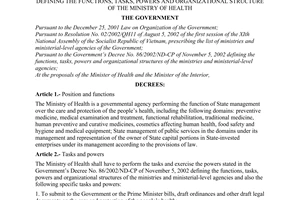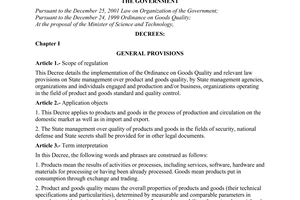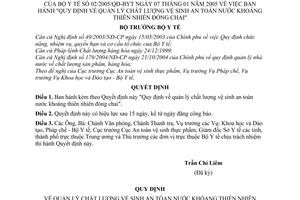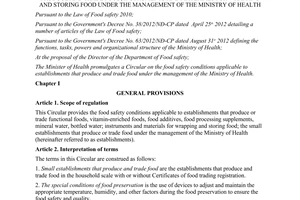Decision No.02/2005/QD-BYT, of the Ministry of Health, promulgating the Regulation on management of quality, hygiene and safety of bottled natural mineral water đã được thay thế bởi Circular No. 16/2012/TT-BYT on the food safety conditions applicable to establis và được áp dụng kể từ ngày 05/12/2012.
Nội dung toàn văn Decision No.02/2005/QD-BYT, of the Ministry of Health, promulgating the Regulation on management of quality, hygiene and safety of bottled natural mineral water
|
THE
MINISTRY OF PUBLIC HEALTH |
SOCIALIST
REPUBLIC OF VIET NAM |
|
No.02/2005/QD-BYT |
Hanoi, January 07, 2005 |
DECISION
PROMULGATING THE REGULATION ON MANAGEMENT OF QUALITY, HYGIENE AND SAFETY OF BOTTLED NATURAL MINERAL WATER
THE MINISTER OF HEALTH
Pursuant to the Government's Decree No.
49/2003/ND-CP dated May 15, 2003 defining the functions, tasks, powers and
organizational structure of the Ministry of Health;
Pursuant to the December 24, 1999 Ordinance on Goods Quality;
Pursuant to the Government's Decree No. 179/2004/ND-CP dated October 21, 2004
prescribing the State management over quality of goods and products;
At the proposal of the Director of the Department for Food Safety and Hygiene,
the Director of the Legal Department and the Director of the Department for
Science and Training of the Ministry of Health,
DECIDES:
Article 1. To promulgate together with this Decision the Regulation on management of quality, safety and hygiene of bottled natural mineral water.
Article 2. This Decision takes effect 15 days after its publication in the Official Gazette.
Article 3. The director of the Ministry Office, the Chief Inspector, the Director of the Science and Training Department and the Legal Department of the Ministry of Health, the Director of the Department for Food Safety and Hygiene, the directors of the provincial/municipal Health Services and the heads of units attached to the Ministry of Health shall have to implement this Decision.
|
FOR THE MINISTER OF HEALTH |
REGULATION
ON MANAGEMENT OF QUALITY, HYGIENE AND SAFETY OF BOTTLED
NATURAL MINERAL WATER
(Issued together with the Ministry of Health’s Decision No. 02/2005/QD-BYT
dated January 7, 2005)
Chapter I
GENERAL PROVISIONS
Article 1. Governing scope
1. This Regulation governs the management of quality, hygiene and safety of bottled natural mineral water used for refreshment purpose
Article 2. Subjects of application
This Regulation applies to Vietnamese as well as foreign organizations and individuals producing and trading in bottled natural mineral water in Vietnam.
Article 3. Interpretation of terms
In this Decision, the following terms are construed as follows:
1. Bottled natural mineral water means water clearly distinguishable from other ordinary types of drinking water because:
a) It has certain contents of a number of mineral salts in their proportional correlations, with the presence of microelements or other components;
b) It is exploited directly from natural sources or drilled wells from underground water streams, which are preserved under the best conditions possible within the protection belts to prevent any pollution or any exotic elements, which can affect the physical and chemical quality of natural mineral water;
c) It remains unchanged in terms of composition and stable in terms of flow and temperature in spite of all natural upheavals;
d) It is exploited under conditions, which ensure the initial cleanness in terms of microorganisms and chemical composition of typical components;
e) It is bottled at sources with stringent hygienic requirements and with the application of only technical solutions specified in Clause 1, Article 14 of this Regulation.
2. Bottling at source means the bottling of natural mineral water right at water sources or the conveyance thereof directly from sources to places for processing and bottling through a system of closed and continuous pipelines, ensuring stringent hygienic requirements throughout the course of exploitation and guaranteeing that composition and quality of natural mineral water remain unchanged as compared with its sources.
3. Bottled natural mineral water with natural gas means natural mineral water, which, after the application of the technical solutions specified in Clause 1, Article 14 of this Regulation and after being added again with a gas volume from its very sources, still contains carbon dioxide (CO2) in content similar to that at the water sources.
4. Bottled non-carbonated natural mineral water means natural mineral water which, after the application of the technical solutions specified in Clause 1, Article 14 of this Regulation and after being bottled, contains no free carbon dioxide (CO2) content in excess of the necessary content to retain hydro carbonate salts dissolved in water.
5. Natural mineral water with little natural gas means natural mineral water, which, after the application of the technical solutions specified in
Clause 1, Article 14 of this Regulation and after being bottled, contains a carbon dioxide (CO2) content lower than that at sources.
6. Natural mineral water added with natural gas from sources means natural mineral water which, after the application of technical solutions specified in Clause 1, Article 14 of this Regulation and after being added with a gas volume from its very sources, contains a carbon dioxide (CO2) content higher than that at sources.
7. Bottled natural mineral water added with gas means natural mineral water obtained, after the application of technical solutions specified in Clause 1, Article 14 of this Regulation and after being added with food carbon dioxide (CO2).
8. Technical solutions mean treating solutions used in the process of producing bottled natural mineral water specified in Clause 1, Article 14 of this Regulation.
Chapter II
REGULATIONS ON PRODUCTION AND IMPORT OF BOTTLED NATURAL MINERAL WATER
Article 4. Production of bottled natural mineral water
1. Organizations and individuals shall be allowed to exploit natural mineral water only after being granted by the Ministry of Environment and Science’s permits for exploitation of minerals (mineral water) according to law provisions on minerals.
2. Organizations and individuals shall be allowed to produce bottled natural mineral water only after being granted by the Ministry of Health (the Food Hygiene and Safety Department) certificates of satisfaction of good hygiene and safety conditions.
3. Organizations and individuals producing bottled natural mineral water must notify the food quality, hygiene and safety standards to the Ministry of Health (the Food Hygiene and Safety Department) according to law provisions before their products are circulated on the market.
4. Organizations and individuals producing bottled natural mineral water shall only be allowed to treat and bottle natural mineral water at sources.
Article 5. Import of bottled natural mineral water
1. Organizations and individuals importing bottled natural mineral water must fully observe the State quality inspection contents and procedures as prescribed by the Ministry of Health.
2. Organizations and individuals importing bottled natural mineral water must notify the food quality, hygiene and safety standards to the Ministry of Health (the Food Hygiene and Safety Department) according to law provisions before their products are circulated on the market.
Chapter III
REGULATIONS ON HYGIENIC CONDITIONS APPLICABLE TO ESTABLISHMENTS PRODUCING BOTTLED NATURAL MINERAL WATER
Article 6. Position, structure and designing
1. Position
Establishments producing bottled natural mineral water must be built in isolation from areas, which are likely to cause food pollution.
2. General structure
a) Production establishments must be designed and built on the one-dimension principle in compatibility with the order of processes in production chains and shall be sectioned into separate areas, so as to avoid cross pollution between processes or areas.
b) Total acreage and acreage structure between areas must be compatible with designed capacity of establishments, thus avoiding overload situation which can easily cause contamination and difficulties in maintenance, cleaning and inspection.
c) The vicinities of areas under establishments’ management must be ensured with a clean environment; yards and passages within such areas must be smoothly paved or asphalted to avoid dusts and stagnant water.
3. Designing
a) Wall and ceiling surface must be flat, bright and easy to be cleaned; the water-proof wall sections must be at least 2 meters high.
b) House floors must be made of water-proof materials and easy for cleaning, and have a proper slope for water drainage.
c) Doors must be tight, made of water-proof materials and easy for cleaning.
d) The system to prevent the intrusion by harmful insects and animals must be made of stainless materials, easy for cleaning and installed to prevent to the utmost the intrusion by harmful insects and animals.
e) The ventilation system must be arranged so as to preclude condensed steam, dust, hot air and polluted gases; direction of the ventilation system must ensure that air must not be ventilated from contaminated areas to clean areas.
f) The bottle-filling workshop must be closed and equipped with sterilization system equipment in such system must be controlled so that they can always operate in good conditions.
g) Water source protection zone must be built so that it can ward off dust and prevent the intrusion by harmful insects and animals.
h) There must be an appropriate number of locker rooms; specifications of locker rooms' walls and floors must comply with the provisions of Points a and b, Clause 3 of this Article.
Article 7. Processing facilities, equipment and tools
1. Equipment and tools used in direct contact with natural mineral water must be those exclusively used for foodstuffs, made of stainless and non-corrosive materials, which do not emit nor are contaminated with toxic and hazardous substances and do not diffuse strange smells to products.
2. Equipment and tools used in the production process must be made of stainless materials, cause no contamination to products, be easy to clean and be regularly cleaned upon each production shift.
3. There must be special-use tools for collecting and storing garbage and waste.
Article 8. Water drainage system
1. Water-draining ditches on floors must ensure good water drainage. Ditches must be made of impermeable materials and be of sizes suitable to the maximum flow of wastewater and have lids made of water-proof materials and with appropriate number and sizes of water drainage holes. Wastewater-draining ditches must be structured for easy cleaning.
2. Pits for settling solid waste must be arranged in compatibility with wastewater flow and drainage ditch networks. Pits must have lids and be easy for cleaning and sterilization. Pits must be arranged outside production areas.
3. Wastewater conduits outside production areas to wastewater tanks and treating quarters must have lids, which are easy to be disassembled and cleaned.
4. Establishments producing bottled natural mineral water must carry out the treatment of waste according to law provisions on environment. Waste-treating areas must be built inside protection fences of establishments to prevent the intrusion by animals.
Article 9. Sanitation regime
1. Workshops, equipment, facilities and tools used in the production process must be periodically sanitized.
2. General sanitization of production establishments must be carried out at least once every six months.
3. Water pipes, beams, pillars and places where dirt usually accumulates must be regularly sanitized in order to minimize the growth of microorganisms.
4. Chemicals, insecticides and germicides used in establishments producing bottled natural mineral water must satisfy the current regulations.
Article 10. Water closet areas
1. Establishments producing bottled natural mineral water must have water closet areas isolated from production areas.
2. Water closets must be structured in a way that their doors must not be directed towards production areas.
3. Each water closet must be furnished with a hand-washing sink where soap, hand towels or hand dry-blowers are available.
4. Water closets must be regularly cleaned.
5. The number of water closets must satisfy the labor sanitation standards promulgated together with the Health Minister's Decision No. 3733/2002/QD-BYT dated October 10, 2002.
Article 11. Water and steam
1. Water used in production processes must satisfy the drinking water hygiene standards promulgated together with the Minister of Health's Decision No. 1329/2002/BYT/QD dated April 18, 2002.
2. Water not up to the requirements prescribed in Clause 1 of this Article shall be used only for such purposes as freezing, fire fighting, supply to steam boilers and other purposes and must not be connected to water sources used for production and must be marked with specific signs in order to avoid misuse.
Chapter IV
RESPONSIBILITIES OF OWNERS OF ESTABLISHMENTS AND REGULATIONS APPLICABLE TO PERSONS DIRECTLY ENGAGED IN PRODUCTION
Article 12. Responsibilities of owners of establishments
1. To organize training courses on knowledge about food safety and hygiene for persons directly engaged in production.
2. To organize health-checks at least once a year at medical establishments of district or higher level for persons directly engaged in production.
3. To conduct periodical assays of comprehensive quality of water sources and finished water product at least once every six months at recognized or designated assaying bodies.
Article 13. Regulations applicable to persons directly engaged in production
1. Persons who are infected with contagious diseases prescribed by the Ministry of Health must not be engaged in production.
2. Persons directly engaged in production must satisfy all personal hygiene requirements while in production process and attend all training courses on knowledge about food safety and hygiene.
3. Persons directly engaged in production must satisfy the following requirements while in production process:
a) To wear specific outfits. Persons working in bottle-filling workshops must wear clean hats, gauze masks and disposable gloves or wash their hands with sterilizing soap;
b) To keep their fingernails short, clean and jewelry-free;
c) To wash their hands with clean water and soap, then dry them with towels:
- When starting to work;
- After touching dirty surfaces;
- After toilet.
d) Not to eat, drink, take chewing gum, smoke, hawk or spit.
Chapter V
REGULATIONS ON PRODUCTION PROCESS AND TECHNICAL REGULATIONS ON BOTTLED NATURAL MINERAL WATER
Article 14. Technical solutions
1. Natural mineral water shall only be allowed to be processed for bottling by using one or combined technical solutions as follows, provided that such technical solutions do not change contents of basic constituents of natural mineral water as compared with its sources:
a) Separation of unstable constituents as well as compounds containing iron, manganese, sulfur or arsenic by decanting and/or filtering, and in case of necessity, through quick treatment by method of prior aeration;
b) De-aeration or aeration of carbon dioxide (CO2);
c) Sterilization by ultraviolet ray.
2. It is strictly prohibited to carry natural mineral after in tanks for bottling before it is bottled at sources.
Article 15. Regulations on production process
1. Throughout the processes of bottle filling and capping, attention must be paid so as to avoid damaging bottles and to prevent foreign objects from falling into bottles. Filling and capping equipment must be supervised and regularly maintained so as to ward off danger of product contamination. The supervision and maintenance must be fully recorded in writing.
2. Bottle filling and capping equipment must be kept in clean and hygienic conditions; they must be cleansed and sterilized as soon as the production starts, or at least once a week if the production is non-interrupted.
3. Bottles must be capped right after the filling process.
4. Bottle caps must be guaranteed airtight before circulation.
Article 16. Technical regulations
1. Requirements regarding health safety-related norms of bottled natural mineral water are specified in Appendix 1 of this Regulation.
2. Requirements regarding microorganisms of bottled natural mineral water are specified in Appendix 2 of this Regulation.
Chapter VI
REGULATIONS ON LABELING, CONTAINING PACKAGES, PRESERVATION AND TRANSPORT
Article 17. Labeling
The labeling of bottled natural mineral water must comply with the Regulation on labeling of domestically circulated goods, and export as well as import goods, which was promulgated together with the Prime Minister’s Decision No. 178/1999/QD-TTg dated August 30, 1999 and legal documents guiding the said Regulation. Besides, the labeling of bottled natural mineral water must comply with the following regulations:
1. Product appellations
a) Product appellations must bear the inscription of "Natural mineral water"
b) In addition to that, depending on each type of natural mineral water, labels must be inscribed with the following appellations:
- Natural mineral water with natural gas;
- Non-carbonated natural mineral water;
- Natural mineral water with little natural gas;
- Natural mineral water added with gas from source;
- Natural mineral water added with gas.
2. Names of mineral water sources and areas where mineral sources exist must be clearly inscribed in product labels.
3. Chemical composition
a) Total dissolved solids (TDS), chemical constituents of bottled natural mineral water (sodium, calcium, potassium, magnesium, iodine, and fluoride, HCO3) and their contents, as well as technical solutions used in the production of bottled natural mineral water must be inscribed in product labels.
b) If bottled natural mineral water products contain more than 1 mg of fluoride per liter, product labels must be inscribed with ''containing fluoride.''
If bottled natural mineral water products contain more than 2 mg of fluoride per liter, product labels must be inscribed with ''product not used for under-seven children.''
4. It is prohibited to inscribe in labels curative effects of products or other health-related effects.
5. Advertisements which may cause misunderstanding of the nature, origin, composition and characteristics of bottled natural mineral water circulated on the market are prohibited.
Article 18. Containing packages
1. Packages used to contain natural mineral water must be of types exclusively used for food, tightly closed and of appropriate sizes, thus avoiding imitation and water pollution.
2. Bottle caps and plastic bottles of a capacity of under 10 liters must not be reused.
3. Plastic cans of a capacity of 10 liters or more and glass bottles may be reused.
4. All types of bottles and cans used for the first time or reused must be cleansed, sterilized and carefully rinsed before the bottle-filling process, except for those used for the first time and manufactured with closed technology chains with sterilization. At bottle-cleansing areas, the sterilization, rinsing, cleaning processes must be supervised and supervision results must be recorded in writing.
5. After being rinsed, bottles must be laid upside down to avoid dusts and foreign objects from falling therein, except for cases where bottles are cleansed by automatic machines.
Article 19. Preservation
1. Bottled natural mineral water must be put into hygienic containers, which can protect products against clash and disproportion in the course of transportation.
2. Products must be preserved at dry, airy and hygienic places.
Article 20. Transportation
Bottled natural mineral water must be transported by means, which do not affect the quality, hygiene and safety of products.
Chapter VII
IMPLEMENTATION PROVISIONS
Article 21. Organizations and individuals that produce and/or trade in bottled natural mineral water shall have to implement this Regulation.
Article 22. The Food Safety and Hygiene Department shall assume the prime responsibility for, and coordinate with the functional departments of the Ministry of Health and the concerned agencies in guiding and directing the implementation of this Regulation.





